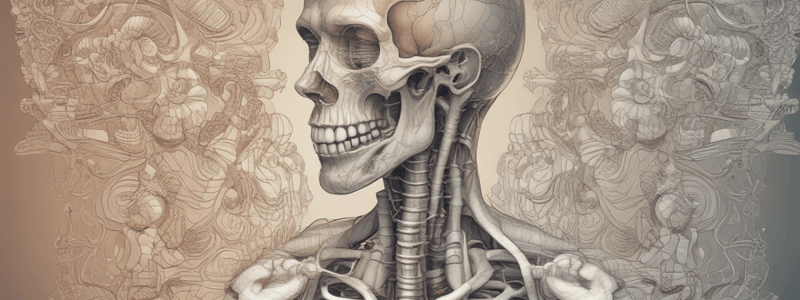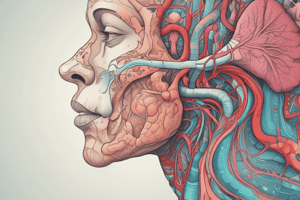Podcast
Questions and Answers
What is the primary function of the respiratory system?
What is the primary function of the respiratory system?
- To move oxygen into the body and carbon dioxide out of the body (correct)
- To regulate body temperature
- To digest food and absorb nutrients
- To circulate blood throughout the body
What is the purpose of the mucus lining in the nose?
What is the purpose of the mucus lining in the nose?
- To carry blood vessels in the nose
- To trap bacteria and other unwanted particles (correct)
- To produce snot during a cold
- To warm the air entering the body
What is the name of the structure that receives air from the nose and mouth?
What is the name of the structure that receives air from the nose and mouth?
- Nasopharynx
- Trachea
- Larynx
- Pharynx (correct)
What would happen if your mouth and nose were blocked?
What would happen if your mouth and nose were blocked?
What is the function of the thin-walled blood vessels in the nose?
What is the function of the thin-walled blood vessels in the nose?
What is the primary function of the epiglottis?
What is the primary function of the epiglottis?
What happens when air moves through the respiratory tract?
What happens when air moves through the respiratory tract?
What is the purpose of the trachea?
What is the purpose of the trachea?
Why is it important to keep the trachea open?
Why is it important to keep the trachea open?
What happens when food or water accidentally gets routed into the trachea?
What happens when food or water accidentally gets routed into the trachea?
Flashcards are hidden until you start studying
Study Notes
The Respiratory System
- The respiratory system is responsible for moving oxygen into the body and carbon dioxide out of the body.
Importance of Mouth and Nose
- The mouth and nose are the only holes that allow for the passage of air into the body.
- If the mouth and nose are blocked, it's a problem for survival.
Upper Respiratory Tract
- The upper respiratory tract includes the nose, throat, larynx, and trachea.
- The nose channels air into the body, regardless of its shape or size.
- The mouth can also channel air into the body, but it has other unrelated responsibilities like eating and smiling.
Nose
- The nostrils are the openings on the bottom of the nose that allow air to enter the body.
- The mucus-covered inner walls of the nose have tiny blood vessels and hairs.
- The blood vessels carry warm blood that helps to warm the air entering the body.
- The sticky mucus lining and hairs trap bacteria and other unwanted things, preventing them from entering the body.
Throat (Pharynx)
- The throat receives air that comes in through the nose and mouth.
- The throat is a passageway for both food going to the stomach and air going to the lungs.
- The epiglottis, a flap of tissue inside the throat, acts like a lid that covers the path to the lungs when swallowing, ensuring food goes down the right tube.
Larynx (Voice Box)
- The larynx is located inside the throat and enables sound production when talking, singing, and laughing.
- The epiglottis covers the larynx when swallowing, preventing food from entering the voice box.
- Air moving through the respiratory tract causes vocal cords to vibrate, creating sound.
Trachea (Windpipe)
- The trachea is a firm tube located in the upper part of the chest that carries air to the lungs.
- The trachea is the only passageway for air to get into the lungs, making it important to keep it open.
- Coughing is a reflex that forcibly pushes air out of the lungs to push objects out of the trachea.
Studying That Suits You
Use AI to generate personalized quizzes and flashcards to suit your learning preferences.




